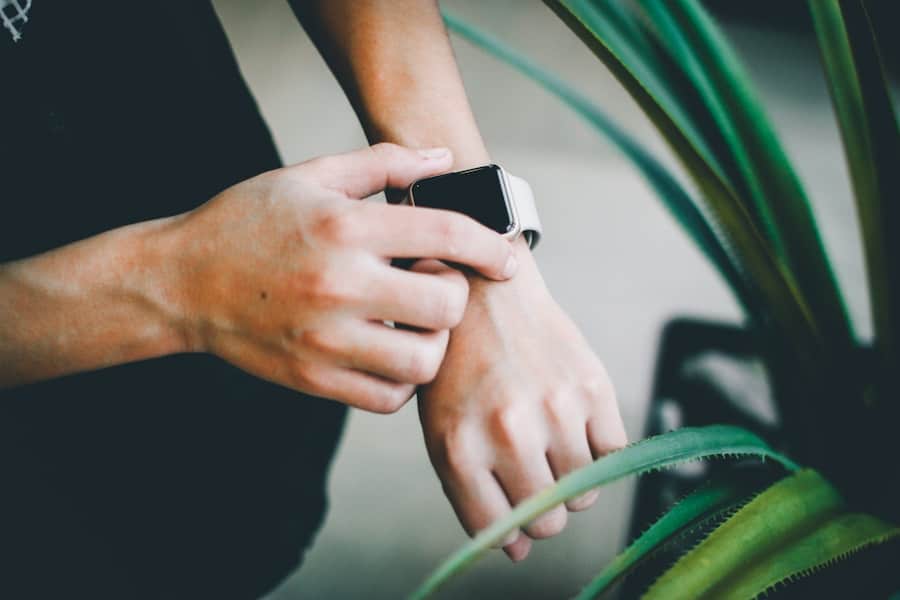Smart rings are a burgeoning category of wearable technology that combines the functionality of traditional smart devices with the convenience and subtlety of jewelry. Unlike smartwatches or fitness trackers, which are often bulky and conspicuous, smart rings are designed to be sleek and unobtrusive. They can be worn on any finger and come in various styles, materials, and sizes, making them appealing to a wide range of users.
These devices are equipped with sensors that can monitor various health metrics, including heart rate, sleep patterns, and physical activity levels. Some models even incorporate advanced features such as NFC for contactless payments or Bluetooth connectivity for notifications. The technology behind smart rings is continually evolving, with manufacturers integrating more sophisticated sensors and algorithms to enhance their capabilities.
For instance, some smart rings can track body temperature, blood oxygen levels, and even stress indicators through physiological responses. This data is then synced with mobile applications, allowing users to gain insights into their health and wellness. As the demand for discreet health monitoring grows, smart rings are becoming increasingly popular among tech-savvy individuals who seek to maintain their well-being without the bulk of traditional wearables.
Key Takeaways
- Smart rings are wearable devices that can track various health and wellness metrics, including emotional wellness and stress levels.
- Smart rings play a significant role in tracking emotional wellness by monitoring factors such as heart rate variability, sleep patterns, and activity levels.
- Smart rings measure stress levels through the analysis of physiological indicators such as heart rate, skin temperature, and movement patterns.
- The benefits of using smart rings for emotional wellness include real-time feedback, personalized insights, and the ability to track progress over time.
- Limitations and challenges of smart rings in tracking emotional wellness include accuracy issues, limited research, and the need for further validation and development.
- The future of smart rings in emotional wellness and stress tracking looks promising, with advancements in technology and increased integration with other health and wellness platforms.
- Smart rings can be compared to other wearable devices for emotional wellness tracking, such as smartwatches and fitness trackers, offering a more discreet and convenient option for monitoring stress levels.
- Tips for using smart rings to improve emotional wellness and manage stress include setting personalized goals, utilizing the data for self-reflection, and seeking professional guidance for interpretation and action.
The Role of Smart Rings in Tracking Emotional Wellness
Tracking Physiological Markers
By tracking markers such as heart rate variability, sleep quality, and activity levels, these devices can offer insights into how stress and emotional fluctuations affect their well-being. For example, a sudden increase in heart rate or a decrease in HRV may indicate heightened stress or anxiety, prompting users to take proactive measures to manage their emotional health.
Personalized Feedback and Recommendations
The integration of smart rings with mobile applications allows for personalized feedback and recommendations based on the collected data. Users can set goals related to their emotional wellness, such as improving sleep quality or reducing stress levels, and receive tailored advice on how to achieve these objectives.
Empowering Emotional Health
This data-driven approach empowers individuals to take charge of their emotional health by fostering self-awareness and encouraging positive behavioral changes. As a result, smart rings serve not only as monitoring devices but also as tools for personal growth and emotional resilience.
How Smart Rings Measure Stress Levels

Smart rings utilize a variety of sensors to measure stress levels through physiological indicators. One of the primary metrics used is heart rate variability (HRV), which refers to the variation in time between successive heartbeats. A higher HRV is generally associated with a relaxed state, while a lower HRV can indicate stress or anxiety.
Smart rings equipped with photoplethysmography (PPG) sensors can accurately measure heart rate and HRV by detecting changes in blood volume in the microvascular bed of tissue.
In addition to HRV, smart rings may also track other physiological signals that correlate with stress levels.
For instance, some models can measure skin temperature and galvanic skin response (GSR), which reflects changes in sweat gland activity due to emotional arousal. When an individual experiences stress, their body may exhibit changes in temperature and perspiration that can be detected by these sensors. By analyzing this data in conjunction with heart rate metrics, smart rings can provide a comprehensive picture of an individual’s stress response and overall emotional state.
The Benefits of Using Smart Rings for Emotional Wellness
The benefits of using smart rings for emotional wellness are manifold. Firstly, their discreet design allows users to monitor their emotional health without drawing attention to themselves.
Additionally, the continuous monitoring capabilities of smart rings enable users to track their emotional states throughout the day, providing valuable insights into how various activities or situations impact their well-being. Another significant advantage is the ability to set personalized goals and receive actionable feedback based on real-time data. For example, if a user notices a pattern of increased stress during specific times of the day or after particular activities, they can adjust their routines accordingly.
This level of self-awareness fosters proactive management of emotional health, allowing individuals to implement stress-reduction techniques such as mindfulness practices or physical exercise when needed. Furthermore, many smart rings come equipped with features that promote healthy habits, such as reminders to take breaks or engage in relaxation exercises.
Limitations and Challenges of Smart Rings in Tracking Emotional Wellness
Despite their advantages, smart rings also face limitations and challenges in effectively tracking emotional wellness. One primary concern is the accuracy of the data collected by these devices. While advancements in sensor technology have improved measurement precision, factors such as movement artifacts or poor sensor placement can lead to inaccuracies in heart rate or HRV readings.
Consequently, users may receive misleading information about their emotional states, which could hinder their ability to manage stress effectively. Another challenge lies in the interpretation of the data provided by smart rings. While these devices can offer insights into physiological responses associated with stress, they do not account for the complex interplay of psychological and environmental factors that contribute to emotional wellness.
For instance, an individual may experience high HRV due to relaxation techniques but still feel emotionally overwhelmed due to external stressors like work pressure or personal relationships. Therefore, while smart rings can be valuable tools for monitoring physiological indicators of stress, they should be used in conjunction with other methods of emotional assessment for a more holistic understanding.
The Future of Smart Rings in Emotional Wellness and Stress Tracking

The future of smart rings in the realm of emotional wellness and stress tracking appears promising as technology continues to advance. Manufacturers are likely to enhance the capabilities of these devices by integrating more sophisticated sensors that can provide deeper insights into emotional states. For instance, future iterations may include sensors capable of detecting hormonal changes associated with stress or anxiety, offering a more comprehensive view of an individual’s emotional health.
Moreover, as artificial intelligence (AI) and machine learning algorithms become more prevalent in health technology, smart rings could leverage these advancements to provide personalized recommendations based on user data patterns. For example, AI could analyze historical data from a user’s smart ring to identify triggers for stress and suggest tailored coping strategies or lifestyle adjustments. This level of personalization could significantly enhance the effectiveness of smart rings as tools for emotional wellness management.
Comparing Smart Rings to Other Wearable Devices for Emotional Wellness Tracking
When comparing smart rings to other wearable devices designed for emotional wellness tracking, several key differences emerge. Smartwatches and fitness trackers often come equipped with larger displays that allow for more interactive features such as notifications and apps related to mental health. However, this added functionality comes at the cost of portability; many users find these devices cumbersome for all-day wear compared to the lightweight nature of smart rings.
In contrast, while smart rings may lack some advanced features found in larger wearables, they excel in providing continuous monitoring without being intrusive. Their small size makes them ideal for individuals who prefer a minimalist approach to technology while still wanting access to vital health metrics. Additionally, some studies suggest that users may be more likely to engage with their health data when using less conspicuous devices like smart rings, leading to improved adherence to wellness practices over time.
Tips for Using Smart Rings to Improve Emotional Wellness and Manage Stress
To maximize the benefits of using smart rings for emotional wellness and stress management, users should consider several practical tips. First and foremost, it is essential to establish a routine for checking the data provided by the device regularly. By reviewing trends in heart rate variability or sleep patterns over time, individuals can gain valuable insights into how their lifestyle choices impact their emotional health.
Incorporating mindfulness practices into daily routines can also enhance the effectiveness of smart ring usage. For instance, users might set aside time each day for meditation or deep-breathing exercises when they notice elevated stress levels indicated by their device. Additionally, leveraging the goal-setting features available through associated mobile applications can help users stay motivated and accountable in their journey toward improved emotional wellness.
Furthermore, it is crucial for users to remember that while smart rings provide valuable data on physiological responses related to stress, they should not replace professional mental health support when needed. Engaging with mental health professionals can provide deeper insights into emotional challenges and offer tailored strategies for coping with stressors effectively. By combining the use of smart rings with professional guidance and self-care practices, individuals can create a comprehensive approach to managing their emotional wellness effectively.
Smart rings are not the only innovative technology making waves in the tech world. Huawei has recently released a new laptop that is being hailed as one of the best laptops of 2023. This Huawei laptop boasts impressive features and performance, catering to the needs of modern users. In addition, the rise of NFTs has been a hot topic in the digital art world. If you’re curious about what NFTs are and how they work, check out this article on here.
FAQs
What are smart rings?
Smart rings are wearable devices that are designed to track various aspects of health and wellness, including physical activity, sleep patterns, and emotional wellness.
How do smart rings track emotional wellness and stress?
Smart rings use sensors to monitor physiological indicators such as heart rate variability, skin temperature, and sleep patterns to assess emotional wellness and stress levels. They can also analyze patterns in activity and behavior to provide insights into emotional well-being.
What are the benefits of using smart rings to track emotional wellness and stress?
By tracking emotional wellness and stress, smart rings can help individuals gain a better understanding of their mental health and make informed decisions about managing stress and improving overall well-being. They can also provide valuable data for healthcare professionals to assess and support their patients’ emotional wellness.
Are smart rings accurate in tracking emotional wellness and stress?
Smart rings have been shown to provide accurate measurements of physiological indicators related to emotional wellness and stress, but it’s important to note that they are not a replacement for professional medical advice or diagnosis. Users should interpret the data provided by smart rings in conjunction with guidance from healthcare professionals.
What are some popular smart rings that track emotional wellness and stress?
Popular smart rings that track emotional wellness and stress include the Oura Ring, Motiv Ring, and Moodmetric Ring. These devices offer a range of features for monitoring and analyzing emotional well-being and stress levels.

